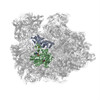+Search query
-Structure paper
| Title | Structural basis of highly conserved ribosome recycling in eukaryotes and archaea. |
|---|---|
| Journal, issue, pages | Nature, Vol. 482, Issue 7386, Page 501-506, Year 2012 |
| Publish date | Feb 22, 2012 |
 Authors Authors | Thomas Becker / Sibylle Franckenberg / Stephan Wickles / Christopher J Shoemaker / Andreas M Anger / Jean-Paul Armache / Heidemarie Sieber / Charlotte Ungewickell / Otto Berninghausen / Ingo Daberkow / Annette Karcher / Michael Thomm / Karl-Peter Hopfner / Rachel Green / Roland Beckmann /  |
| PubMed Abstract | Ribosome-driven protein biosynthesis is comprised of four phases: initiation, elongation, termination and recycling. In bacteria, ribosome recycling requires ribosome recycling factor and elongation ...Ribosome-driven protein biosynthesis is comprised of four phases: initiation, elongation, termination and recycling. In bacteria, ribosome recycling requires ribosome recycling factor and elongation factor G, and several structures of bacterial recycling complexes have been determined. In the eukaryotic and archaeal kingdoms, however, recycling involves the ABC-type ATPase ABCE1 and little is known about its structural basis. Here we present cryo-electron microscopy reconstructions of eukaryotic and archaeal ribosome recycling complexes containing ABCE1 and the termination factor paralogue Pelota. These structures reveal the overall binding mode of ABCE1 to be similar to canonical translation factors. Moreover, the iron-sulphur cluster domain of ABCE1 interacts with and stabilizes Pelota in a conformation that reaches towards the peptidyl transferase centre, thus explaining how ABCE1 may stimulate peptide-release activity of canonical termination factors. Using the mechanochemical properties of ABCE1, a conserved mechanism in archaea and eukaryotes is suggested that couples translation termination to recycling, and eventually to re-initiation. |
 External links External links |  Nature / Nature /  PubMed:22358840 / PubMed:22358840 /  PubMed Central PubMed Central |
| Methods | EM (single particle) |
| Resolution | 6.6 - 7.2 Å |
| Structure data |  EMDB-2008: |
| Chemicals |  ChemComp-ADP:  ChemComp-SF4:  ChemComp-MG:  ChemComp-ATP:  ChemComp-HOH: |
| Source |
|
 Keywords Keywords | TRANSLATION/TRANSPORT PROTEIN / ribosome recycling / ribosome / archaea / TRANSLATION-TRANSPORT PROTEIN complex / translation / eukarya |
 Movie
Movie Controller
Controller Structure viewers
Structure viewers About Yorodumi Papers
About Yorodumi Papers









 pyrococcus furiosus (archaea)
pyrococcus furiosus (archaea)